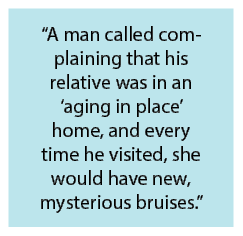Many seniors are aware of the Long-Term Care Ombudsman Program and its role as their advocate if they have a problem or concern regarding a nursing home, adult residential care home, assisted living facility or community care foster family home.
What they may not know, however, is that if they choose to live in what is called an “aging in place” facility, residents are very much on their own. The Long-Term Care Ombudsman Program does not have access to these facilities, and their “renters” are not protected by federal or state regulations that govern licensed settings.
There is some debate as to whether or not these homes are actually “unlicensed” care homes taking advantage of loopholes in the current law. But there is no debate that AIG Homes have:
- No annual inspection by the Department of Health.
- No public posting of the inspection by the
Department of Health. - No TB clearance requirements for the caregivers or staff.
- No building or fire code requirements or plans regarding emergency evacuations.
- No access to the Ombudsman or consumer protection.
Since these homes are not licensed, and don’t want to be licensed, another significant concern is this: Why would a social worker, case manager, doctor, nurse or other professional make such a recommendation? Do they bear some liability if the person is abused, mistreated or neglected? Would healthcare providers, such as Kaiser or HMSA, place a patient in an unregulated, unmonitored home? The Long-Term Care Ombudsman Program has already received complaints about loved ones being denied access. A man called complaining that his relative was in an “aging in place” home, and every time he visited, she would have new, mysterious bruises. He complained to the caregiver, but to no avail. Then he noticed the caregiver started covering up the bruises in various ways to hide them. He took pictures and sent them to the person with the placement responsibility over his relative who, unfortunately, didn’t live in Hawaii. That person forwarded the pictures to the caregiver, and she immediately banned the man from visiting. He called our Office to request help, as he is the only relative on the island and hasn’t been allowed to visit since April.
The Long-Term Care Ombudsman Program has already received complaints about loved ones being denied access. A man called complaining that his relative was in an “aging in place” home, and every time he visited, she would have new, mysterious bruises. He complained to the caregiver, but to no avail. Then he noticed the caregiver started covering up the bruises in various ways to hide them. He took pictures and sent them to the person with the placement responsibility over his relative who, unfortunately, didn’t live in Hawaii. That person forwarded the pictures to the caregiver, and she immediately banned the man from visiting. He called our Office to request help, as he is the only relative on the island and hasn’t been allowed to visit since April.
He wanted to know if I could do anything to lift the ban. Sadly no. Our Office can’t do anything because the home is unlicensed. Representatives from our Office could be arrested for trespassing on private property.
Most of us believe if you are taking care of someone in your home for a fee — and that person is not related to you — then you need to be licensed by the state, so we can try to ensure your safety. Licensed facilities are regulated by laws, which allow the state to do what is necessary to ensure the safety and security of our residents through compliance with building and safety codes, health inspections, emergency plans, care plans, medication management, and training and experience for caregivers.
The “aging in place” model is not licensed and doesn’t allow for these safeguards. Until they do, they should be shut down.
DO YOU HAVE COMPLAINTS AND QUESTIONS?
Please call John G. McDermott, the State Long-Term Care Ombudsman, at 808-586-7268 or refer to the Department of Health’s website at www.health.hawaii.gov/ohca/state-licensing-section/.


Leave a Reply